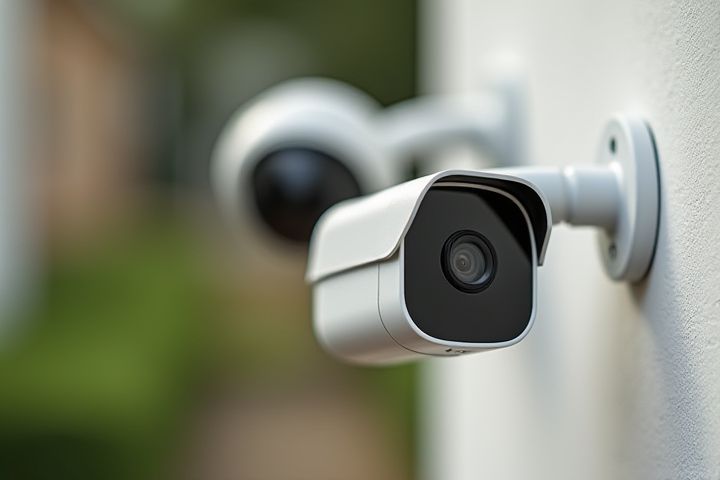
For optimal security coverage, install house cameras at key locations such as entry points like doors and windows, which are common entryways for intruders. Position outdoor cameras to monitor driveways and backyards, ensuring visibility across the entire perimeter of your property. Indoors, place cameras in areas like hallways and main living spaces, offering a clear view of movement throughout your home. Ensure cameras are mounted at an appropriate height to capture faces and avoid obstructions, while also considering direct sunlight that may cause glare or poor visibility. Finally, connect your cameras to a reliable power source and secure Wi-Fi network to facilitate real-time monitoring and alerts.
Where To Install House Cameras
Main entrance
Install house cameras at the main entrance to enhance security and monitor visitor activity effectively. Position one camera to capture a clear view of the doorway, including any steps or pathways leading up. A second camera can be placed to cover the surrounding area, such as the front yard and driveway, providing a comprehensive overview of approaching guests or potential intruders. Ensure the cameras have night vision capabilities for 24/7 surveillance and choose weather-resistant models for outdoor use.
Back or side doors
For optimal security, install house cameras focusing on back and side doors, as these are common entry points for intruders. Position cameras to cover the full range of motion around each door, ensuring they are unobstructed by plants or decor. Aim for high-resolution cameras that can capture clear footage, even in low light, to enhance your surveillance quality. You may also want to consider motion detection features to receive alerts whenever movement is detected near these vulnerable areas.
Ground floor windows
For optimal security, install house cameras near ground floor windows to monitor potential entry points. Position cameras at a height of 8 to 10 feet for a clear view, ensuring they have a wide field of vision. Consider placing them at different angles to cover adjacent areas, enhancing surveillance effectiveness. Ensure that the cameras are equipped with night vision capabilities for around-the-clock monitoring, safeguarding your home at all times.
Garage or driveway
When choosing the optimal location for house cameras, consider installing them in the garage and driveway to enhance security. In the garage, a camera can monitor access points, deterring potential intruders from entering your home. Positioning a camera facing the driveway captures vehicle movements, providing crucial evidence in case of theft or vandalism. Make sure to choose high-resolution cameras with night vision capabilities to ensure clear footage at all times.
Backyard or backyard gate
When deciding where to install house cameras, consider placing them in the backyard and near the backyard gate for optimal security. Positioning a camera in the backyard allows you to monitor any suspicious activity or unauthorized entry into your property. Installing another camera by the gate will provide a clear view of visitors and deliveries, enhancing your overall safety. Both locations contribute to a comprehensive surveillance system that keeps your home secure.
Common living areas
To maximize security and surveillance, house cameras should be installed in common living areas such as the entryway, living room, and kitchen. Position a camera at the front door to monitor visitors and package deliveries, while a centrally located camera in the living room can capture movement throughout the main social area. Installing a camera in the kitchen helps ensure safety and accountability, especially around valuables or potential hazards. Consider choosing cameras with wide-angle lenses and night vision capabilities to cover larger spaces and enhance visibility in low-light conditions.
Stairways
Installing house cameras near stairways is essential for enhancing safety and security. Position cameras at both the top and bottom of the stairway to capture any potential incidents from multiple angles, ensuring clear visibility. Opt for high-definition cameras with a minimum resolution of 1080p to clearly identify individuals, especially in low-light conditions, which is crucial for nighttime safety. Consider adding motion sensors that alert you to any movements, further increasing your peace of mind and surveillance effectiveness.
Outdoor high points
Installing house cameras at outdoor high points, such as the eaves of your roof or elevated areas like second-story balconies, enhances your property's security by broadening the field of view. Positioning cameras in these locations allows for better surveillance of entrances, driveways, and backyard activities, reducing blind spots. Ensure that the cameras are sheltered from harsh weather conditions while also maintaining a clear line of sight to capture any potential intruders or unusual activity. When planning the installation, consider factors such as lighting conditions and camera resolution to optimize monitoring effectiveness.
Indoor blind spots
To effectively monitor indoor blind spots, install cameras in corners of rooms, ideally at a height between 7 to 10 feet for optimal visibility. Key areas include entryways, staircases, and hallways, ensuring comprehensive coverage of high-traffic zones. Consider placing cameras in rooms like the living room and kitchen, where valuable items or family activities occur. You may also want to use wide-angle lenses to capture a larger field of view, minimizing the chances of missing critical events.
Children's room or nursery
Installing house cameras in your child's room or nursery can enhance security and provide peace of mind. Positioning cameras at entry points, like doors and windows, ensures you monitor access. Opt for models with infrared capabilities for clear night vision, as it's crucial to observe your child in low-light conditions. Aim for a height of 7 to 10 feet to avoid tampering while maintaining a clear view of the entire space.
